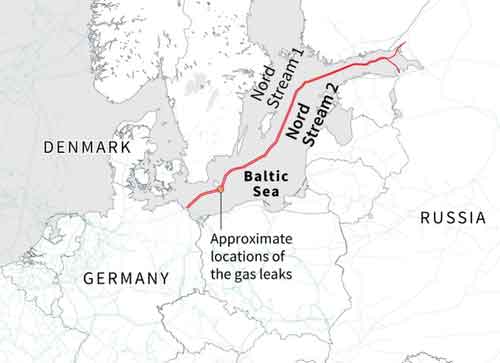Germany Believes High Explosive Devices Equivalent To "500 Kilograms Of TNT" Used To Destroy Nord Stream
Tyler Durden
 German newspaper Der Spiegel reported that German security officials believe "highly effective explosive devices" were used to blow up the Nord Stream pipelines in the Baltic Sea. German newspaper Der Spiegel reported that German security officials believe "highly effective explosive devices" were used to blow up the Nord Stream pipelines in the Baltic Sea.
According to SPIEGEL information, it was calculated that explosive devices with an effect comparable to that of 500 kilograms of TNT must have been used to destroy the tubes. The seismic signals registered by various measuring stations were also included in the estimate.
The previously unknown estimates support the assumption that only a state actor can be behind the action. So far, the federal government has held back with speculation about the background to the interruption of the pipelines.
There is a lot of speculation that Russia is behind the action. The Russian leadership, however, described the process as international terrorism directed against Russia.
The federal government is hoping for more information from a more detailed examination of the Nord Stream 1 and 2 pipelines, which are interrupted to the north-east and south-east of the Baltic Sea island of Bornholm. In security circles it was said that divers or a remote-controlled robot could possibly assess the damage at the weekend.
In the best-case scenario, one could then draw initial conclusions about the type of explosion under water and the explosives used, according to security circles. However, it is difficult to predict how many traces can still be found. -- Der Spiegel
The blasts were so large that the Swedish National Seismic Network detected a 1.9 on the Richter scale and another one that registered 2.3...
Two powerful underwater explosions were detected on Monday in the same area of sea as the Nord Stream gas leaks, according to the Swedish National Seismic Network.
The monitoring network said the first explosion occurred on Monday at 2:03 a.m. Swedish time with a magnitude of 1.9 on the Richter scale, followed by a second at 7:04 p.m. on the same day with a magnitude of 2.3.
To get an idea of what the bombs had to rip through to damage the tubes, Bloomberg's Javier Blas shows NS1 and NS2 were inches thick of steel coated with tons of concrete on each section. Blas said each tube is 'very strong'.
What sparked our attention is why did the CIA warn Germany of an attack on Nord Stream weeks in advance?
And now NATO Secretary-General Jens Stoltenberg called the Nord Stream attack "sabotage" and said it would be met with a "determined response."
* * *
Update (0735ET):
Reuters quoted NATO Secretary-General Jens Stoltenberg on Thursday, saying attacks against EU critical infrastructure would be met with a "determined response." He called the acts "sabotage. "
"All currently available information indicates that this is the result of deliberate, reckless, and irresponsible acts of sabotage.
"We, as Allies, have committed to prepare for, deter and defend against the coercive use of energy and other hybrid tactics by state and non-state actors. Any deliberate attack against Allies' critical infrastructure would be met with a united and determined response," a statement from the North Atlantic Council (NATO) read.
Separately Stoltenberg tweeted:
Stoltenberg nor NATO named the culprit behind the pipeline attacks, though some EU officials have suggested Russia.
There was no mention of how NATO "arrived at its assessment that the damage, which it said has caused substantial environmental fallout and shipping disruptions, resulted from the intentional attack," WSJ noted.
NATO's statement is a significant increase in tensions between Russia and the West ahead of Russian President Vladimir Putin's move to annex parts of eastern Ukraine.
More details on the fourth Nord Stream leak are below.
* * *
Sweden's coastguard confirmed a new leak was discovered on the damaged Nord Stream pipeline system in the Baltic Sea on Thursday, according to Reuters. Add this to the three other leaks for a grand total of four that have been spewing natural gas into the water since Monday.
"Two of these four are in Sweden's exclusive economic zone," coast guard spokesperson Jenny Larsson told Svenska Dagbladet newspaper. He said the other two are situated in the Danish exclusive economic zone.
While neither NS1 nor NS2 was operational during the suspected undersea explosions earlier this week, they were filled with NatGas to Germany, with Denmark estimating the leaks would dissipate by Sunday.

There are two massive gas bubbles on the surface of the Baltic above the damaged pipelines in Sweden's economic zone. One gas bubble measures a staggering 2,950 feet in diameter, while the other is about 600 feet.

Several EU heads have called the incident "deliberate" and "sabotage," with Finland stating that only a state actor was capable of the pipeline attack.
The Baltic region is getting more intense by the day as Norway, now Europe's top natural gas supplier (recently displaced Russia), increased security at energy infrastructure sites, land terminals, and platforms on the Norwegian continental shelf. There were reports of mysterious drones buzzing oil rigs.
The UN Security Council will meet Friday at Russia's request to review the damage to NS1 and NS2. Russia's US embassy asked for the meeting as it "insists on the need for a comprehensive and objective examination of the circumstances of the unprecedented attacks on Russian pipelines."
Reuters said the embassy commented on its Telegram channel that the US attempts to "squeeze out" Russian oil firms from the global energy market through "non-market methods and sanctions."
The Russian prosecutor's office told Interfax the Nord Stream incident is being investigated as an "international terrorism" probe.
For now, NS1 appears as if it won't be operational anytime soon (NS2 was never operational though filled with gas). Before this winter and the reduction in NS1 capacity, the EU received about 40% of its NatGas via pipelines from Russia, a figure that Bloomberg now has around 9%.
 our mission: our mission:
to widen the scope of financial, economic and political information available to the professional investing public.
to skeptically examine and, where necessary, attack the flaccid institution that financial journalism has become.
to liberate oppressed knowledge.
to provide analysis uninhibited by political constraint.
to facilitate information's unending quest for freedom.
our method: pseudonymous speech...
Anonymity is a shield from the tyranny of the majority. it thus exemplifies the purpose behind the bill of rights, and of the first amendment in particular: to protect unpopular individuals from retaliation-- and their ideas from suppression-- at the hand of an intolerant society.
...responsibly used.
The right to remain anonymous may be abused when it shields fraudulent conduct. but political speech by its nature will sometimes have unpalatable consequences, and, in general, our society accords greater weight to the value of free speech than to the dangers of its misuse.
Though often maligned (typically by those frustrated by an inability to engage in ad hominem attacks) anonymous speech has a long and storied history in the united states. used by the likes of mark twain (aka samuel langhorne clemens) to criticize common ignorance, and perhaps most famously by alexander hamilton, james madison and john jay (aka publius) to write the federalist papers, we think ourselves in good company in using one or another nom de plume. particularly in light of an emerging trend against vocalizing public dissent in the united states, we believe in the critical importance of anonymity and its role in dissident speech. like the economist magazine, we also believe that keeping authorship anonymous moves the focus of discussion to the content of speech and away from the speaker- as it should be. we believe not only that you should be comfortable with anonymous speech in such an environment, but that you should be suspicious of any speech that isn't.
www.zerohedge.com
| 

